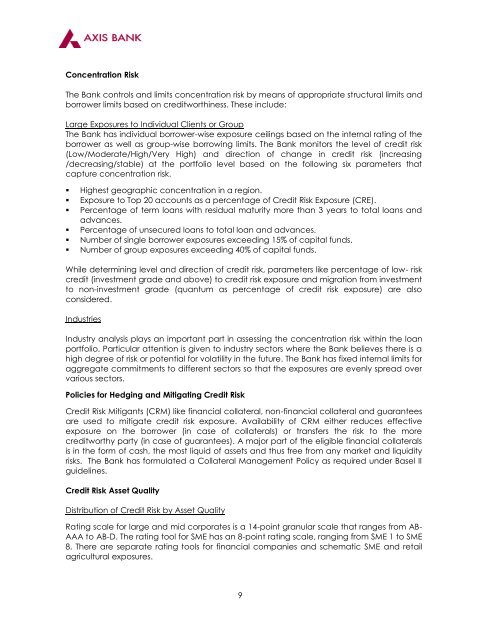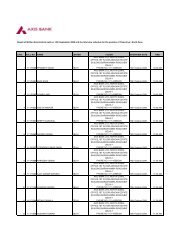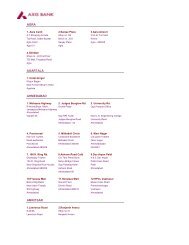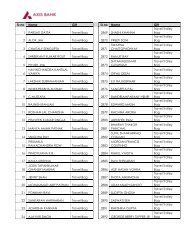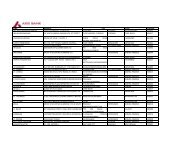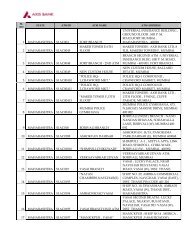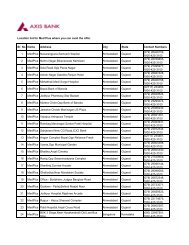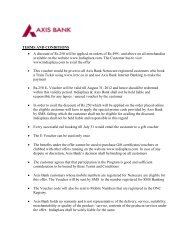Scope of Application
Scope of Application
Scope of Application
You also want an ePaper? Increase the reach of your titles
YUMPU automatically turns print PDFs into web optimized ePapers that Google loves.
Concentration Risk<br />
The Bank controls and limits concentration risk by means <strong>of</strong> appropriate structural limits and<br />
borrower limits based on creditworthiness. These include:<br />
Large Exposures to Individual Clients or Group<br />
The Bank has individual borrower-wise exposure ceilings based on the internal rating <strong>of</strong> the<br />
borrower as well as group-wise borrowing limits. The Bank monitors the level <strong>of</strong> credit risk<br />
(Low/Moderate/High/Very High) and direction <strong>of</strong> change in credit risk (increasing<br />
/decreasing/stable) at the portfolio level based on the following six parameters that<br />
capture concentration risk.<br />
� Highest geographic concentration in a region.<br />
� Exposure to Top 20 accounts as a percentage <strong>of</strong> Credit Risk Exposure (CRE).<br />
� Percentage <strong>of</strong> term loans with residual maturity more than 3 years to total loans and<br />
advances.<br />
� Percentage <strong>of</strong> unsecured loans to total loan and advances.<br />
� Number <strong>of</strong> single borrower exposures exceeding 15% <strong>of</strong> capital funds.<br />
� Number <strong>of</strong> group exposures exceeding 40% <strong>of</strong> capital funds.<br />
While determining level and direction <strong>of</strong> credit risk, parameters like percentage <strong>of</strong> low- risk<br />
credit (investment grade and above) to credit risk exposure and migration from investment<br />
to non-investment grade (quantum as percentage <strong>of</strong> credit risk exposure) are also<br />
considered.<br />
Industries<br />
Industry analysis plays an important part in assessing the concentration risk within the loan<br />
portfolio. Particular attention is given to industry sectors where the Bank believes there is a<br />
high degree <strong>of</strong> risk or potential for volatility in the future. The Bank has fixed internal limits for<br />
aggregate commitments to different sectors so that the exposures are evenly spread over<br />
various sectors.<br />
Policies for Hedging and Mitigating Credit Risk<br />
Credit Risk Mitigants (CRM) like financial collateral, non-financial collateral and guarantees<br />
are used to mitigate credit risk exposure. Availability <strong>of</strong> CRM either reduces effective<br />
exposure on the borrower (in case <strong>of</strong> collaterals) or transfers the risk to the more<br />
creditworthy party (in case <strong>of</strong> guarantees). A major part <strong>of</strong> the eligible financial collaterals<br />
is in the form <strong>of</strong> cash, the most liquid <strong>of</strong> assets and thus free from any market and liquidity<br />
risks. The Bank has formulated a Collateral Management Policy as required under Basel II<br />
guidelines.<br />
Credit Risk Asset Quality<br />
Distribution <strong>of</strong> Credit Risk by Asset Quality<br />
Rating scale for large and mid corporates is a 14-point granular scale that ranges from AB-<br />
AAA to AB-D. The rating tool for SME has an 8-point rating scale, ranging from SME 1 to SME<br />
8. There are separate rating tools for financial companies and schematic SME and retail<br />
agricultural exposures.<br />
9


